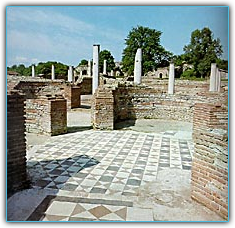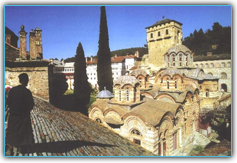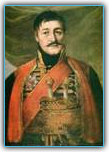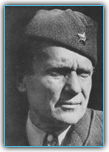Brief History Of Serbia
I was born in 1978, in the city of Novi Sad, Socialist Federative Republic of Yugoslavia. I graduated from high school in 1993, in Novi Sad, Federal Republic of Yugoslavia. And now I am a citizen of Serbia, the country where my hometown, Novi Sad, is. So I basically lived in 4 countries but never changed the address on my ID card. You can imagine that that was particularly hard on the sports fans who had to change their cheering songs for the international games every time the country changed its name ;). But anyway, that's just the tip of the iceberg, and here is the rest of the story.
Once upon a time.....

Gamzigrad (Felix Romuliana) near the city of Zajecar : the ruins of late-Roman fortress (3rd and 4th century AD) unveil the remains of a palace with exceptionally fine mosaics, public baths and impressive city gates.
Medieval Times ( 7th - 14th century)
Like other southern Slavic tribes, Serbs came to Balkans during the great migration in 6th and 7th century AD. The earliest records of Serbs on Balkans, we can find in the records of Byzantine Emperor Konstantinos VII "Porphyrogenitus" in 10th century. During that time Serbs were populating the territory of present western Serbia, east and central Bosnia, Herzegovina with Adriatic coast, and on the south up to river Lime and Prokletije mountains.
Serbian Monastery Hilandar on Mt. Athos, Greece. Built in 1199 on the ruins of old Hilandar monastery by Sava Nemanjic and his father Stefan Nemanja (Simeon, the name he took when becoming a monk).First Serbian state was formed under the Viseslavic Dynasty. During that time Bulgaria and Byzantine posed a large threat to Serbian state. However, Byzantine played a major role for the future of Serbian people: at the end of IX century Serbs started leaving their pagan religion behind and adopting Christianity as their new religion. This period was the first rise of Serbian nation but then came the downfall that lasted up to the end of XII century.
After fighting his brothers, Stefan Nemanja, the founder of Nemanjic dynasty, came on the throne in 1170. He had the title of "veliki zupan" (a title equivalent to the prince) and started restoring the Serbian state in the Raska region. He expanded the state to the east and the south and annexed the Zeta region. he also constructed a fair number of monasteries. His endowments include the Djurdjevi Stupovi Monastery and the Studenica Monastery in the Raska region, and the Hilandar Monastery on Mt. Athos.
Stefan Nemanja's successor was his middle son Stefan, while his youngest son Rastko became a monk, taking the name Sava, and dedicated his like to spreading religion among his people. In 1217, Stefan asked the crown from the Pope and became the firs Serbian king. In 1219 his brother Sava secured the autocephalous status of Serbian church and became the first Serbian archbishop.

St. Sava Fresco, Mileseva Monastery.Then came the period of stagnation with the next three kings Radoslav, Vladislav and Uros. However, when the son of Uros, Milutin, came to the throne, Hungarian King Ladislaus IV gave him lands in northeastern Bosnia, the regions of Srem and Macva, and the city of Belgrade, which will become the capital of Serbian State. King Milutin was also building churches that are now the greatest examples of Medieval Serbian architecture: the Gracanica Monastery in Kosovo, the Cathedral in Hilandar Monastery on Mt. Athos, the St. Archangel Church in Jerusalem etc. Because of this he was proclaimed a saint.
Medieval Serbia enjoyed a high political, economic and cultural reputation in Medieval Europe. It reached its peak in mid-14th century, during the rule of Tzar Stefan Dusan. St. Sava's Nomocanon, Dushan's Code (the greatest juridical achievement of Medieval Serbia), frescoes and the architecture of the medieval monasteries are eternal civilization monuments of the Serbian people from this period. Tzar Stefan Dusan doubled the size of his kingdom seizing territories to the south, southeast and east at the expense of Byzantium. He was succeeded by his son Uros called the Weak, a term that might also apply to the state of the kingdom slowly sliding into feudal anarchy. This is a period marked by the rise of a new threat: the Ottoman Turk sultanate gradually spreading from Asia to Europe and conquering Byzantium first, and then the other Balkan states.
Turkish Rule (14th - 19th century)

Serbs lead by patriarch Arsenije Carnojevic, abandon their homes under Turkish Invasion.The period of Turkish rule came after defeating the Serbian army in two crucial battles: on the banks of the river Marica in 1371 - where the forces of noblemen from Macedonia were defeated, and on Kosovo Polje (Kosovo Plain) in 1389, where the vassal troops commanded by Prince Lazar - the strongest regional ruler in Serbia at the time - suffered a catastrophic defeat. The Battle of Kosovo defined the fate of Serbia, because after it no force capable of standing up to the Turks existed. The Turks continued their conquest until they finally seized the entire Serbian territory in 1459 when Smederevo fell into their hands. Serbia was ruled by the Ottoman Empire for almost five centuries. These were the dark ages. Serbian aristocracy was prosecuted and was being physically exterminated, while the rest of Christian Serbs were abused, humiliated and exploited by Islamic Ottoman Empire. European powers, and Austria in particular, fought many wars against Turkey, relying on the help of the Serbs that lived under Ottoman rule. During the Austrian-Turkish War (1593-1606) in 1594 the Serbs staged an uprising in Banat - the Pannonian part of Turkey, and the sultan retaliated by burning the remains of St. Sava - the most sacred thing for all Serbs honored even by Moslems of Serbian origin.
During the Great War (1683-1690) between Turkey and the Holy Alliance - created with the sponsorship of the Pope and including Austria, Poland and Venice - these three powers incited the Serbs to rebel against the Turkish authorities, and soon uprisings and guerrilla spread throughout the western Balkans. However, when the Austrians started to pull out of Serbia, they invited the Serbian people to come north with them to the Austrian territories. Having to choose between Turkish vengeance and living in a Christian state, Serbs massively abandoned their homesteads and headed north lead by their patriarch Arsenije Carnojevic. Many areas in southern Balkans were de-populated in the process, and the Turks used the opportunity to Islamize Raska, Kosovo and Metohija and to a certain extent Macedonia. A process whose effects are still visible today started. Another important episode in Serbian history took place in 1716-1718, when the Serbian ethnic territories ranging from Dalmatia, and Bosnia and Herzegovina to Belgrade and the Danube basin newly became the battleground for a new Austria-Turkish war launched by Prince Eugene of Savoy. The Serbs sided once again with Austria. After a peace treaty was signed in Pozarevac, Turkey lost all its possessions in the Danube basin, as well as northern Serbia and northern Bosnia, parts of Dalmatia and the Peloponnesus.
The last Austrian-Turkish war was the so called Dubica War (1788-1791), when the Austrians newly urged the Christians in Bosnia to rebel. No wars were fought afterwards until the 20th century that marked the fall of both mighty empires.
Modern Serbia (1804-1918)

St. Sava Fresco, Mileseva Monastery. Serbian resistance to Ottoman domination, latent for many decades surfaced at the beginning of 19th century with the First and Second Serbian Uprising in 1804 and 1815. The Serbs launched not only a national revolution but a social one as well and gradually Serbia started to catch up with the European states with the introduction of the bourgeois society values. Resulting from the uprisings and subsequent wars against the Ottoman Empire, the independent Principality of Serbia was formed and granted international recognition in 1878.
This period was marked by the alternation of two dynasties descending from Djordje Petrovic - Karadjordje, leader of the First Serbian Uprising and Milos Obrenovic, leader of the Second Serbian Uprising. Proclamation of the Kingdom of Serbia came in 1882.
In the second half of 19th century Serbia was integrated into the constellation of European states and the first political parties were founded thus giving new momentum to political life.
In 1903, Karadjordje's grandson came to the throne with the title of King Petar I opened the way for parliamentary democracy in Serbia. Then came a period of parliamentary government and political freedom interrupted by the outbreak of the liberation wars. The Balkan wars 1912 - 1913, terminated the Turkish domination in the Balkans. Turkey was pushed back across the channel, and national Balkan states were created in the territories it withdrew from.
The assassination of Austrian Crown Prince Franc Ferdinand in Sarajevo in 1914, served as a pretext for the Austrian attack on Serbia that marked the beginning of World War I. The Serbian Army bravely defended its country and won several major victories, but it was finally overpowered by the joint forces of Germany, Austria-Hungary and Bulgaria, and had to withdraw from the national territory marching across the Albanian mountain ranges to the Adriatic Sea. Having recuperated on Corfu the Serbian Army returned to combat on the Thessalonike front together with other Entante forces comprising France, England, Russia, Italy and the United States. In world War I Serbia had 1.264.000 casualties - 28% of its population (4.529.000) which also represented 58% of its male population - a loss it never fully recuperated from. This enormous sacrifice was the contribution Serbia gave to the Allied victory and the remodeling of Europe and of the World after World War I.
The Kingdom of Yugoslavia (1918-1941)
With the end of World War I and the downfall of Austria-Hungary and the Ottoman Empire the conditions were met for proclaiming the Kingdom of Serbs, Croats and Slovenians in December of 1918. The Yugoslav ideal had long been cultivated by the intellectual circles of the three nations that gave the name to the country, but the international constellation of political forces and interests did not permit its implementation until then. However, after the war, idealist intellectuals gave way to politicians and the most influential Croatian politicians opposed the new state right from the start.
Trying to prevent weakening of the country, King Aleksandar I banned national political parties in 1929, assumed executive power and renamed the country Yugoslavia. He hoped to curb separatist tendencies and mitigate nationalist passions. However the balance of power changed in international relations: in Italy and Germany Fascists and Nazis rose to power, and Stalin became the absolute ruler in the Soviet Union. None of these three states favored the policy pursued by Aleksandar I. In fact the first two wanted to revise the international treaties signed after World War I, and the Soviets were determined to regain their positions in Europe and pursue a more active international policy. Yugoslavia was an obstacle for these plans and King Aleksandar I was the pillar of the Yugoslav policy.
During an official visit to France in 1934, the king was assassinated in Marseilles by a member of VMRO - an extreme nationalist organization in Bulgaria that had plans to annex territories along the eastern and southern Yugoslav border - with the cooperation of the Ustashi - a Croatian fascist separatist organization. Supported and pressured by Fascist Italy and nazi Germany, Croatian leader Vlatko Macek and his party managed to extort the creation of the Croatian banovina (administrative province) in 1939. The agreement specified that Croatia were to remain part of Yugoslavia, but it was hurriedly building an independent political identity in international relations.
World War II (1941-1945)
At the beginning of the 40's, Yugoslavia found itself surrounded by hostile countries. Except for Greece, all other neighboring countries had signed agreements with either Germany or Italy. Hitler was strongly pressuring Yugoslavia to join the Axis powers. The government was even prepared to reach a compromise with him, but the spirit in the country was completely different. Public demonstrations against Nazism prompted a brutal reaction. Luftwaffe bombed Belgrade and other major cities and in April 1941, the Axis powers occupied Yugoslavia and disintegrated it. The western parts of the country together with Bosnia and Herzegovina were turned into a Nazi puppet state called the Independent State of Croatia (NDH) and ruled by the Ustashe. Serbia was occupied by German troops, but the northern territories were annexed by Hungary, and eastern and southern territories to Bulgaria. Kosovo and Metohija were mostly annexed by Albania which was under the sponsorship of fascist Italy. Montenegro also lost territories to Albania and was then occupied by Italian troops. Slovenia was divided between Germany and Italy that also seized the islands in the Adriatic.
Following the Nazi example, the Independent State of Croatia established extermination camps and perpetrated an atrocious genocide killing over 750.000 Serbs, Jews and Gypsies. This holocaust set the historical and political backdrop for the civil war that broke out fifty years later in Croatia and Bosnia and Herzegovina and that accompanied the break-up of Yugoslavia in 1991-1992.
As a resistance many Serbs joined the Partisan forces (National Liberation Army headed by Josib Broz Tito) in the liberation war and thus helped the Allied victory. By the end of 1944, with the help of the Red Army the Partisans liberated Serbia and by May 1945 the remaining Yugoslav territories, meeting up with the Allied forces in Hungary, Austria and Italy. Serbia and Yugoslavia were among the countries that had the greatest losses in the war: 1.700.000 (10.8% of the population) people were killed and national damages were estimated at 9.1 billion dollars according to the prices of that period.
Socialist Federal Republic of Yugoslavia (1945-1991)

Josip Broz TitoWhile the war was still raging, in 1943, a revolutionary change of the social and state system was proclaimed with the abolition of monarchy in favor of the republic. Josip Broz Tito became the first president of the new - socialist - Yugoslavia. Socialist Yugoslavia was established as a federal state comprising six republics: Serbia, Croatia, Slovenia, Bosnia and Herzegovina, Macedonia and Montenegro and two autonomous regions - Vojvodina and Kosovo and Metohija. The two autonomous regions were at the same time integral part of Serbia. Because of such an administrative division and due to historical reasons, the Serbs - the most numerous of the Yugoslav peoples - lived in all six republics and both autonomous regions.
The Break-up: Federal Republic of Yugoslavia (1992-2003)
Between 1991 and 1992, Slovenia, Croatia and Bosnia and Herzegovina forcibly seceded from Yugoslavia, whilst Macedonia did so peacefully. The break-up of Yugoslavia was endorsed by the international powers that recognized the right of self-determination to all nations except the Serbs which generally wanted to continue living in Yugoslavia. Serbia and Montenegro opted to stay on in the federation and at the combined session of the parliaments of Yugoslavia, Serbia and Montenegro held on April 27 1992 in Belgrade, the Constitution of the Federal Republic of Yugoslavia was passed thus reaffirming the continuity of the state first founded on December 1st 1918.
The End of Yugoslavia: Serbia & Montenegro (2003-2006)
Though only Serbia and Montenegro remained as a part of Yugoslavia, the two republics kept drifting apart which became evident in 2003 when Serbia and Montenegro was constituted on February 4th, and the land of Southern (Yugo-) Slavic (-slavia) land was finally put to rest. We speak the same language, we share a lot of history but it was only a matter of time when this re-defined union will get rid of the "and".
And then there was...one: Serbia (2006-... )
On May 21st 2006, Montenegrian people woted in a referendum that it's time for Serbia and Montenegro to go their own ways....I just hope we both can find them. To sum up: I was born in Socialist Federative Republic of Yugoslavia; I hold a still valid passport which says Federal Republic of Yugoslavia; last time I went home to Serbia & Montenegro was in February of 2006; and I am a citizen of Serbia.
But unfortunately this is not where it will end....
Most of the text has been taken from http://www.serbia-info.com/enc/index.html
